Manuel I Komnenos | Areni Cave | 1204: The Sack of Constantinople | Origins and History
Articles and Definitions | Contents
- Manuel I Komnenos | Who Was
- Areni Cave | Origins
- 1204: The Sack of Constantinople | Origins
Ancient civilizations | Historical places, and their characters
Manuel I Komnenos | Who Was
Definition and Origins
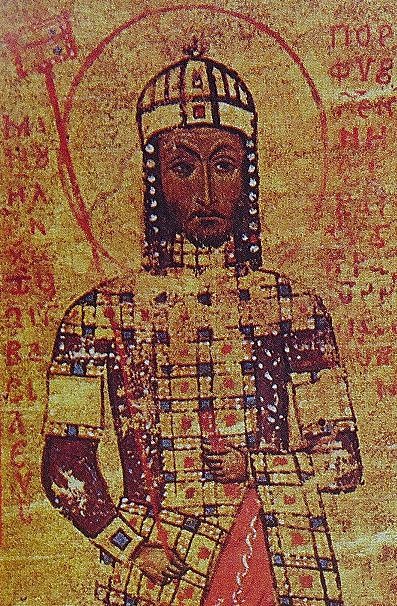
Manuel I Komnenos was emperor of the Byzantine Empirefrom 1143 to 1180 CE. Manuel continued the ambitious campaigns of his grandfather Alexios I and father John II to aggressively expand the boundaries of his empire. Manuel turned out to be more ambitious than his armies could support and, despite useful treaties and marriage alliances, he ultimately came unstuck with a failed invasion of Italy and then a serious defeat at the hands of the Seljuks in Asia Minor.
SUCCESSION
Manuel inherited the throne of the Byzantine Empire when the reign of his father John II Komnenos came to an unexpected end following the emperor’s death in a freak hunting accident on 8 April 1143 CE. Manuel was actually the younger son, but two of his brothers had already died tragically of fever, and John had passed over his elder son Isaac, deeming him unsuitable to rule as he was too easily made angry. John had named Manuel as his successor a few days before he died in Cilicia and the new emperor had been at his father’s side. Manuel’s immediate problem was to get back to Constantinople before his brother Isaac got any ideas of simply taking the throne by force.
MANUEL WOULD SPEND MOST OF HIS REIGN CAMPAIGNING IN EVERY SINGLE CORNER OF HIS EMPIRE.
Fortunately, Manuel had an invaluable ally who would ensure his first few months as emperor went smoothly. This was John Axoukh, megas domestikos or supreme commander of the army during John II’s reign. While Manuel dealt with the funeral arrangements of his father, Axouh dashed off to Constantinople and had Isaac arrested; the Church too was offered a generous annual payment to support the rightful heir. By the time Manuel arrived at his capital a new Patriarch (bishop) had been appointed, and a coronation ceremony was held. Isaac was later released in a typical act of clemency.
The historian J. J. Norwich gives the following character description of Byzantium’s new emperor:
First, he was outstandingly handsome; secondly, there was a charm of manner, a love of pleasure and an enjoyment of life that stood out in refreshing contrast to John’s [his father] high-principled austerity. Yet there was nothing shallow about him. A fine soldier and superb horseman, he was, perhaps, too headstrong to be quite the general that his father had been, but there could be no doubting his energy and courage. A skilful diplomat and a born statesman, he remained the typical Byzantine intellectual, cultivated in both the arts and the sciences. (274-5)
One less appreciative section of Byzantine society was the Church. Like many emperors before him, Manuel took a keen interest in ecclesiastical matters, but the Church hierarchy saw this as meddling and was not enamoured either by his overtures to the Popes or the invitation to visit Constantinople he extended to the Seljuk Sultan. In addition, Manuel’s reputation as a ladies' man did not go unnoticed. Fortunately for the Church elders, Manuel would spend most of his reign campaigning in every single corner of his empire.
FOREIGN POLICY
Alliances
Unlike his predecessors, Manuel seemed greatly attracted to the west. He favoured Latins in Constantinople, dispensing civil awards and military titles in their direction, and the emperor was even known to have participated in western jousting tournaments (and unseated a couple of Italian knights to boot). Manuel may also have introduced the somewhat indecent western novelty of trousers into Byzantine society. He married twice to princesses from the West - first, Bertha of Sulzbach and then, two years after her death, Maria of Antioch, daughter of the ruler of Antioch Raymond of Poitiers, in 1161 CE. Bertha was the sister-in-law of German king and western emperor Conrad III (r. 1138-1152 CE) and the marriage was arranged by Manuel’s father in 1146 CE in order to reinforce the anti-Norman alliance, especially targeted against the Norman king Roger II (r. 1130-1154 CE) in Sicily.
The Second Crusade
After minor victories in Cilicia, Syria, and Asia Minor in 1144-1146 CE, Manuel faced the problem of the Second Crusade of 1147-9 CE. With the goal to secure the Holy Places of Christianity from the Muslims, the Crusaders were held with suspicion by the Byzantines who thought they were really only after the choice parts of the Byzantine Empire. It was for this reason that Manuel insisted the leaders of the crusade swear allegiance to him. At the same time, the western powers considered the Byzantines rather too preoccupied with their own affairs and unhelpful in the noble opportunities they thought a crusade presented.
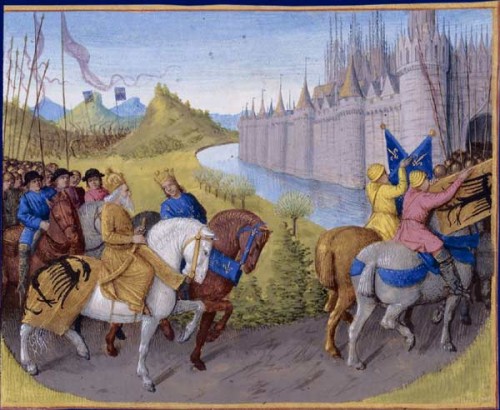
The Second Crusaders Arrive in Constantinople
In more practical terms, as in the First Crusade (1095-1099 CE), the rabble of zealots and men of dubious background seeking absolution which the campaign attracted meant that as soon as the Crusader army hit Byzantine territory on its way east the pillaging, looting, and raping began. This was despite Manuel’s insistence to the leaders that all food and supplies be paid for. Manuel provided a military escort to see the Crusaders on their way as quickly as possible, but fighting between the two armed groups was not infrequent. When the French contingent arrived at the Byzantine capital, things worsened still. Always suspicious of the Eastern Church and now outraged to discover Manuel had signed a truce with the Turks (seen by him as less of a threat than the Crusaders in the short term), sections of the army wanted to storm Constantinople.
The Crusaders were, eventually, persuaded to hurry on their way east with reports of a large Muslim army preparing to block their path in Asia Minor. There they ignored Manuel's advice to stick to the safety of the coast and so met disaster and defeat. The Crusade was also a blow to Manuel’s carefully constructed diplomatic alliances because, involving Conrad III in person, it provided a distraction which allowed Roger the freedom to attack and pillage Kerkyra (Corfu), Euboea, Corinth, and Thebes (where silk and skilled workers were spirited off back to Palermo). Manuel’s attempt to persuade Louis VII, the King of France (r. 1137-1180 CE) who was leading the Crusade, to side with him against Roger failed. In 1149 CE the embarrassment of a Serbian uprising and an attack on the area around Constantinople by George of Antioch’s fleet were offset by the Byzantines recapturing Kerkyra.
Italy & Barbarossa
From 1155 to 1157 CE the Byzantines invaded Italy, helped by their ally Conrad III, although the German king was by then too ill to participate in person. The family ties between the two rulers had been strengthened by the marriage of Manuel’s niece Theodora to Conrad’s brother, Duke Henry of Austria. The expedition, despite the acquisition of Bari in 1155 CE, was a failure thanks to stiff resistance from Roger II’s successor William I of Sicily (r. 1154-1166 CE) who could also claim the support of Louis VII. Manuel was, essentially, let down by his own fickle mercenaries and gutless local rebels. William was thus able to sign a peace settlement with the Byzantines in 1158 CE through which Manuel recognised William as king.

Byzantine Empire c. 1180 CE
Things got worse for the emperor when Conrad died and he was succeeded by Frederick I Barbarossa (r. 1152-1190 CE) in 1152 CE. The long-standing alliance between the two powers was terminated, largely over the issue of Byzantine support for the Lombards and a squabble over possessions in Hungary. Indeed, the regional alliances were reversed as Manuel’s 1158 CE treaty with William also identified Frederick as their common enemy.
In 1172 CE Manuel installed and supported Bela III (r. 1172-1196 CE) on the Hungarian throne and thereby gained the advantage over Frederick. Ties were strengthened further when Manuel had his daughter Maria engaged to Bela, and the Hungarian monarch was given the official title of despot and made heir to the Byzantine throne. When Manuel later had a son of his own, Alexios, the engagement was called off and Alexios was, naturally, nominated as the emperor’s official heir.
VENICE HAD PROVIDED SHIPS TO BOLSTER THE BYZANTINE FLEET IN RETURN FOR TRADE PRIVILEGES SINCE 1126 CE.
Venice
Venice had provided ships to bolster the Byzantine fleet in return for trade privileges at Constantinople and within the Byzantine Empire since 1126 CE but by Manuel’s reign, the Italian Republic had gained a stranglehold on eastern trade. The emperor, therefore, sought to immediately reverse the situation by confiscating Venetian goods, property and ships, and arresting 10,000 traders throughout the empire in 1171 CE. The official pretext was the accusation that the Venetians had torched the quarter of their rivals the Genoese at Galata.
Alternative Italian states such as Genoa and Pisa were supported instead but the effect on Venetian dominance was negligible and, even worse, Venice sent a fleet to exact revenge. Fortunately for Manuel, who had no fleet to respond with, the Venetians were tricked into waiting out a diplomatic parley, and in the meantime, their crews were struck down by a plague. The Doge was forced to return home where he was stabbed by a mob outraged at his incompetence. Venice would have its revenge, though, as the city led the Fourth Crusade against Constantinople in 1204 CE.
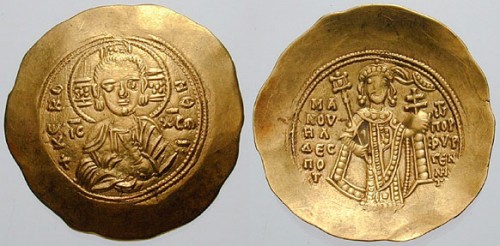
Hyperpyron Coin of Manuel I Komnenos
Myriokephalon
Elsewhere, campaigns went well for Manuel in Armenian Cilicia, Asia Minor, and even against Antioch, still stubbornly in Crusader's hands. On 17 September 1176 CE, though, the emperor suffered a serious defeat at the hands of the Seljuks in Asia Minor, when he was on his way to sack their capital at Iconium. At the battle of Myriokephalon (aka Myriocephalum), Manuel’s army was trapped in a narrow pass in the Phrygian mountains and a full massacre was only avoided by the Sultan Kilij Arslan II generously offering a peace deal. The conditions were that the Byzantines abandon the strategic fortresses of Dorylaeum and Sublaeum. With these losses in men and defences, any further Byzantine ambitions in the region were ended and an enemy had been created who would prove more than troublesome in the coming decades. The emperor’s reign was now almost over, but there was, typically, one final diplomatic coup. Manuel married off his ten-year-old son Alexios to Agnes, aged nine, daughter of Louis VII.
DEATH & SUCCESSOR
Alexios II Komnenos (r. 1180-1183 CE) inherited the throne following his father’s death of natural causes on 24 September 1180 CE, but his reign would be a brief one. In any case too young to rule in his own right, his mother Maria of Antioch acted as his regent, although she favoured her nephew and so Alexios was a mere figurehead. Maria’s pro-western policies and preferential treatment to Italian merchants meant that she quickly acquired enemies at court and amongst the wider public. In 1182 CE Andronikos I Komnenos, a cousin of Manuel’s, led a successful revolt, a number of Latins were butchered in Constantinople, and the regent and young emperor were ousted. Andronikos forced Alexios to condemn his mother to death, and then, in secret, the boy-emperor was strangled and his body thrown into the sea. Andronikos would only rule himself for two years, after which he was overthrown by a popular uprising.
Manuel’s reign, then, had achieved little of lasting substance. He had dazzled at times but really only garnered token victories - expensive ones at that - and whenever his armies were out of sight, the regions turned their back on the emperor and looked after their own interests. The Byzantine Empire had passed its peak and was sailing through troubled waters which would culminate in the terrible storm that was the sack of Constantinople by the Fourth Crusaders in 1204 CE.
Areni Cave | Origins
Definition and Origins
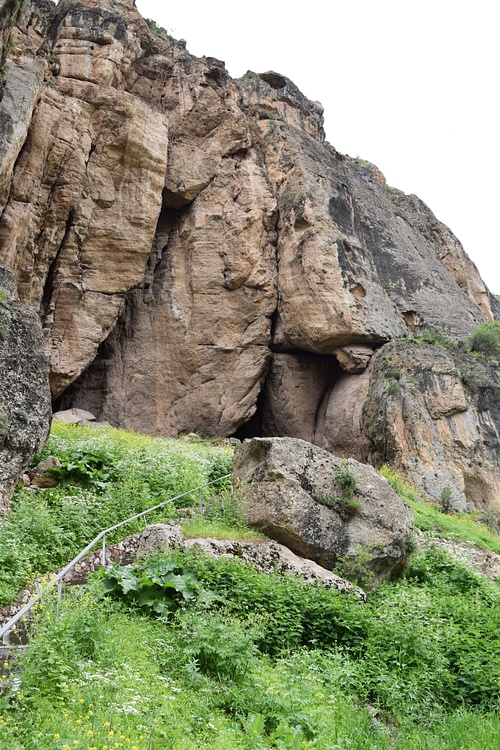
The Areni Cave is a multicomponent cave site with artifacts dating from the Chalcolithic to the Bronze Age. In Armenia, the Areni Cave complex is also known as "Birds’ Cave" ("Trchuneri" in Armenian). Located near the town of Areni, which lies close to the Arpa River and the Gnishik River in Armenia’s central Vayots Dzor Province, the caves are the site at which archaeologists have discovered what is likely the world’s oldest winery, and ancient human brain, the remnants of a 5,000-year-old skirt made of straw, and the world’s oldest leather shoe. The first discovery of artifacts took place in 1997 CE by Boris Gasparian. Successive excavations have continued since that time, and they will continue into the future. The Areni Cave complex is one of the few caves in the Caucasus that is classified as “karstic” with a thick sediment sequence.
PREHISTORY OF THE ARENI CAVES
Excavations of the Areni Cave lead archaeologists and scientists to believe that the caves were inhabited by people during the Late Chalcolithic period (c. 6000-3000 BCE). Archaeologists refer to these people as the “Kura Araxes archaeological culture,” and they inhabited sites scattered across the Caucasus, in what is present-day Armenia, Georgia, and Azerbaijan, as well as in portions of western Iran and eastern Turkey. Roughly contemporaneous with Pre-Dynastic and Early Dynastic Egypt, artifacts made by the Kura Araxes people have been found as far as Iraq, Syria, and Israel. This suggests that the Kura Araxes culture perhaps had wide-ranging cultural and economic importance; some archaeologists go further and believe that migrations might have occurred with Kura Araxes populations moving to the south and southwest.
THE PREHISTORIC KURA ARAXES PEOPLE SEEM TO HAVE USED PITS WITH LARGE CERAMIC POTS FOR GARBAGE DISPOSAL IN THE REAR OF THE CAVE.
Materials recovered from Areni Cave suggest that human activity in the cave occurred over a period of decades or centuries rather than over thousands of years from around the end of the 5th millennium BCE to the beginning of the 4th millennium BCE. Moreover, excavations at Areni Cave indicate the likelihood that there was a division of labor amongst the prehistoric Kura Araxes people and that this is reflected in how the cave was utilized. Scientists and archaeologists contend that the cave was divided into spaces for specific purposes: places of habitation; places of economic and material production; and places designated for ritual and burial rites. Archaeologists have uncovered seeds, walnuts, the remains of charcoal, a bone awl, and obsidian blade, countless ceramic remnants, bones of sheep, goats, and pigs, and several human teeth. The prehistoric Kura Araxes people seem to have used pits with large ceramic pots or vessels for garbage disposal in the rear of the cave. (Curiously, the bones of several children and babies have been found in these trash areas. It is unknown if they were considered “rubbish.”) Plant materials were also placed in ceramic vessels, but it remains uncertain whether they were used for ritual purposes or if they were refuse. Evidence of the scattered bones of animals with butchered marks suggests that Kura Araxes people consumed the meat of goats and sheep.
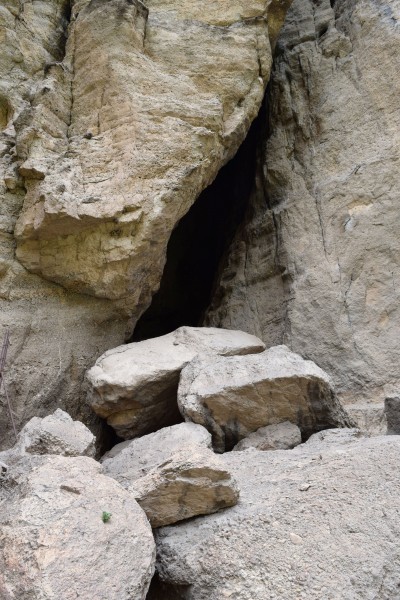
Armenia's Areni Cave
SPECIAL ARTIFACTS RECOVERED FROM ARENI CAVE
From 2007-2011 CE, archaeologists have unearthed what they believe is a 6,100-year-old winery in the Areni Cave. The following objects have been uncovered: basins that ancient people utilized for wine presses; storage vessels; bowls for the consumption of wine; several wine-making tools; fermentation vats; and the remnants of domesticated grape vines. This makes the Areni cave complex one of the oldest sites in the world containing some of the earliest evidence for an established viticulture. The dry conditions in the cave were well-suited for the production of wine. Radiocarbon testing on several pottery shards was dated to c. 4100-4000 BCE. Archaeologists and scientists believe that the ancient peoples who inhabited the Areni Cave might have used wine in some sort of ritual or mortuary practice. Excavations have shown that as many as 20 human burials are located beside the winemaking zone within the cave, and archaeologists have additionally found various drinking cups around the graves.
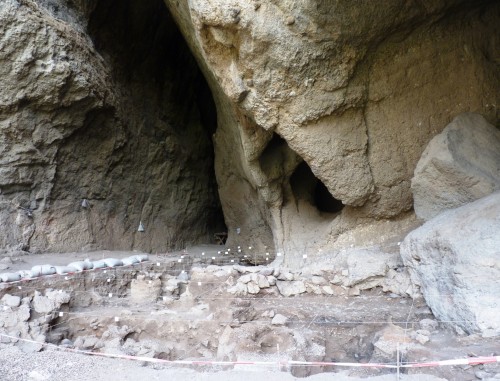
Excavations at the Areni Cave
Archaeologists discovered a 5,500-year-old leather shoe made of cowhide at the Areni Cave in 2010 CE. Dating from 3500 BCE, it is believed that the cold temperatures within the cave, in addition to sheep dung, kept the shoe in a remarkable state of preservation. (Curiously, the shoe was found stuffed with grass as well.) The shoe was likely tailor-made from a single strip of leather cut in half and later tanned separately. The leather shoe surprised archaeologists by its "modern" appearance. While not the oldest shoe in the world, it is the world’s oldest leather shoe. Archaeologists and various scholars believe that the shoe was removed by ancient inhabitants of the cave during a ritual ceremony, which perhaps included wine. In 2010 CE, archaeologists discovered a straw-woven skirt dating to 3900 BCE, and in 2008 CE, they uncovered biological materials consistent with that of a human brain. This portion of human measured 10 cm (4 in) and was so well preserved that it retained visible signs of blood vessels.
This article was made possible with generous support from the National Association for Armenian Studies and Research and the Knights of Vartan Fund for Armenian Studies.
1204: The Sack of Constantinople | Origins
Ancient Civilizations
In 1204 CE the unthinkable happened and Constantinople, after nine centuries of withstanding all comers, was brutally sacked. Even more startling was the fact that the perpetrators were not any of the traditional enemies of the Byzantine Empire: the armies of Islam, the Bulgars, Hungarians, or Serbs, but the western Christian army of the Fourth Crusade. Finally, the mutual suspicion and distrust that had existed for centuries between the western and eastern states and churches had blown up into full-scale warfare. With the fall of the city, many of its religious icons, relics, and artworks were spirited away and the Byzantine Empire was divided up between Venice and its allies. The empire would rise again from the ashes but never again could Constantinople claim to be the greatest, richest, and most artistically vibrant city in the world.
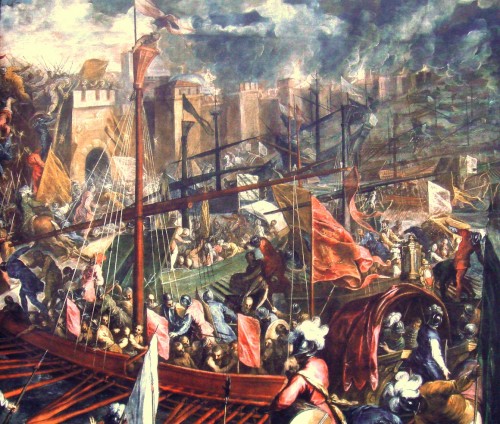
The Sack of Constantinople in 1204 CE
PROLOGUE
The Byzantines, with their capital at Constantinople founded by Roman emperorConstantine I in 324 CE, saw themselves as the defenders of Christendom, the beacon which shone out across the Mediterranean and central Asia, hosts to the holiest city outside Jerusalem, and the rock which stood against the tide of Islam sweeping in from the east. For the western half of the old Roman Empire, though, the Byzantines were regarded as decadent, shifty, and untrustworthy, their religious practices were suspect, and several of their emperors had even proclaimed icons and their veneration as heresy.
The centuries of argument and mistrust, the constant rivalry between Popes and emperors, and the rising ambition of western states to wrest from Byzantium the remnants of its empire in Italy were, for a time, held in check by the first three Crusades. All three, though, would prove to be unsuccessful in permanently securing Christianity’s Holy Places from the Arabs. Worse, they created a damaging rift in east-west relations as blame was apportioned to either side for the lack of success. The Byzantines were considered to lack the will to fight the common enemy while, from the other side, the Crusaders were seen as opportunists out to grab the choicest parts of the Byzantine Empire in the east. In a sense, both sides were right in their judgement.
THE FOURTH CRUSADE WAS LAUNCHED BY POPE INNOCENT III IN 1202 CE WITH THE PRINCIPAL INTENTION OF RECLAIMING JERUSALEM FOR CHRISTENDOM.
The Byzantines had never fully understood the concept of a Holy War, which the western leaders used to rouse armies to be sent to the east. The west considered Byzantine emperors to be only ever interested in the preservation of their empire and perceived superiority over the west. For the emperors, though, they saw the Byzantine Empire and Christendom as one and the same thing, nor could they be criticised for thinking the Crusaders as an unruly mob of miscreants out on a looting party, given the rape and pillaging which often went on as Crusader armies passed through Byzantine territory. These were the experiences and suspicions on both sides leading into the early 13th century CE.
THE FOURTH CRUSADE
The Fourth Crusade was launched by Pope Innocent III (r. 1198-1216 CE) in 1202 CE with the principal intention of reclaiming Jerusalem for Christendom after its fall in 1187 CE to Saladin, Sultan of Egypt (r. 1169-1193 CE). In June 1202 CE the Crusaders assembled in Venice from across Europe, led by Marquis Boniface of Montferrat. From there they sailed to Egypt - seen as the soft underbelly of the enemy - or at least, that was the original plan. The Venetians, being the rapacious traders they were, insisted that their 430 ships be paid for, but the Crusaders could not meet the asking price of 84,000 silver marks. Consequently, a deal was made that in return for passage the Crusaders would stop off at Zara on the Dalmatian coast and reconquer it for the Italians, the city having recently defected to the Hungarians. The Venetians would also provide 50 ships at their own cost and receive half of any territory conquered.
The Pope was not best pleased to hear the news that Christian Zara had been sacked in November 1202 CE, and he promptly excommunicated the Crusaders and the Venetians. The ban was later lifted for the former, otherwise, they would not have been much use as Crusaders, one supposes.
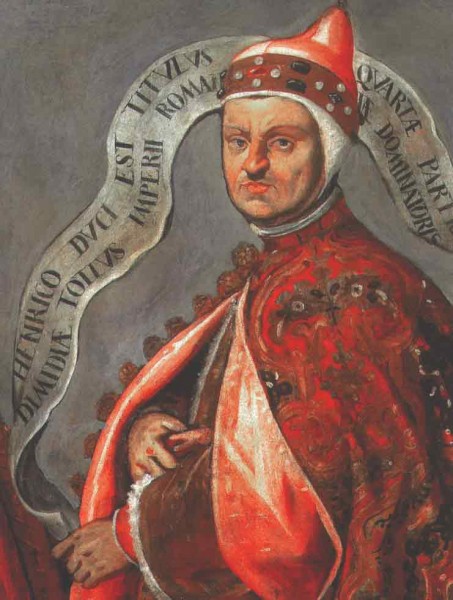
Enrico Dandolo
Historians continue to debate the exact reason why the Crusaders then turned on Constantinople instead of Jerusalem, but one crucial ingredient in the troublesome mix of mutual suspicions between the western powers and Byzantium was the Republic of Venice and one man, in particular, the Doge Enrico Dandolo (r. 1192-1205 CE). Intent on winning Venetian domination of the trade in the east, he well remembered his undignified expulsion from Constantinople when he served as an ambassador. This seemed as good an opportunity as ever to finally knock out Constantinople as a trade competitor. In addition, the Pope would achieve the supremacy of the western Church once and for all and the Crusader knights would not only gain revenge on the duplicitous Byzantines for their unhelpful support of previous Crusades but also surely pick up some glory and handsome booty in the process. The riches of Constantinople could then pay for the rest of the Crusade as it marched on to Jerusalem. It may not have been so cynically planned by all parties but, in the end, it is exactly what happened with the exception that the Fourth Crusade ended with the fall of the Byzantine capital and Jerusalem was left for a later date.
THE ATTACK ON CONSTANTINOPLE
The Crusaders arrived outside Constantinople on 24 June 1203 and played their trump card. The western powers had agreed to back Alexios IV Angelos, the son of the deposed Byzantine emperor Isaac Angelos II (r. 1185-1195 CE) and promised to return his father (then imprisoned in Constantinople) to the throne if he promised to help the Crusaders with money, soldiers, and supplies. One Crusader was especially keen on the plan - Philip of Swabia, king of Germany (r. 1198-1208 CE), whose wife Irene was the sister of Alexios IV. With such credentials as a western pawn in Byzantine politics, Isaac was duly reinstalled in the palace of his ancestors in 1203 CE with Alexios as co-emperor.
Constantinople had fallen remarkably easily once the Crusaders had overcome the garrison at Galata and lowered the massive chain which blocked the harbour of the Golden Horn. Sailing in with their fleet and attacking the sea walls and land walls simultaneously with siege engines and scaling ladders, even the elite Varangian Guard could not prevent the attackers forcing their way into the city. The incumbent emperor and brother of Isaac, Alexios III Angelos, caught completely unprepared by the arrival of the Crusaders, fled the city.
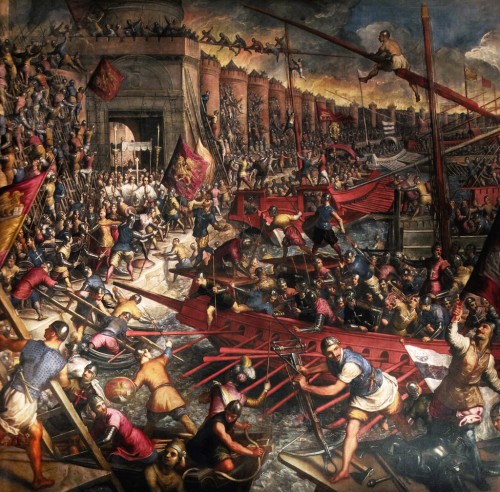
The Venetians Attack Constantinople, 1204 CE
The old regime had fallen. However, the new pair of emperors went back on the arranged deal of assistance - although they had few resources to call on in reality - and also failed to formally make the Byzantine Church subordinate to the Pope. Alexios IV may not have helped the westerners very much but his people did not trust him anyway, given the way he ascended the throne and the presence of the Crusader army still outside the walls of Constantinople. The emperor’s efforts to raise taxes and a massive fire in the city caused by the Crusaders setting a mosque ablaze only added fuel to the people’s discontent. It was no surprise, then, that a usurper came along, one Alexios V Doukas. An army commander and senior diplomat backed by the people, Doukas seized the throne and executed his predecessors, father and son together, in January 1204 CE.
CITIZENS WERE RAPED & MASSACRED, BUILDINGS WERE TORCHED & CHURCHES DESECRATED.
Alexios Doukas, known as Mourtzouphlos or "Bushy-Browed" attempted to put up a serious defence of his capital against unfavourable odds. For now Doge Dandolo and the Crusaders saw their golden opportunity not just to receive aid from the Byzantines but to loot the city entirely for all it was worth. Alexios ensured that the mighty Theodosian Wallswere further strengthened, towers were heightened, and the initiative seized with several raids made on the Crusader camps. The Crusaders retaliated by launching an all-out attack on the morning of 9 April 1204 CE, but the Byzantines repelled it. Then, on 12 April, the Crusaders attacked the weaker sea walls of the harbour and targeted two towers in particular by lashing their ships together and ramming them repeatedly. Initially, the defenders held on, but eventually, the attackers forced their way through on both the sea side and the land side when the Franks finally battered down one of the city gates. The Crusaders were into the city and carnage followed. Citizens were raped and massacred, buildings were torched and churches desecrated. Alexios fled to Thrace, and three days of looting followed.
LOOTING THE CITY
Robert de Clari, a lesser knight of the Crusader army, wrote an interesting account of the Crusade with invaluable descriptions of Constantinople’s monuments and religious relics. Another record, this time by an author closer to the leadership, was compiled by Geoffrey de Villehardouin, the Marshal of Champagne. Villehardouin wrote his Conquest of Constantinople almost as a defence of the Crusaders' actions, and so the work is heavily biased, portraying the Byzantines as a shifty lot who only got their comeuppance. Finally, the Byzantine historian Niketas Choniates gives a vivid eyewitness account of the destruction and looting of the city in his Historia.

Horses from the Hippodrome of Constantinople
Constantinople, in 1204 CE, had a population of around 300,000, dwarfing the 80,000 in Venice, western Europe’s largest city at the time. But it was not only its size that impressed the Crusaders, its buildings, churches and palaces, the huge forums and gardens, and, above all, its riches struck awe in the western visitors. Then awe was swiftly replaced by greed. Monumental sculptures, countless artworks, books, manuscripts, and jewels which had been steadily accumulated by emperors and nobles over a millennium were all stripped away and either destroyed or melted down for coinage. Furniture, doors, and marble architectural elements were taken away for reuse elsewhere, and even the tombs of emperors, including that of the great Justinian I, were opened up and their precious contents removed.
One of the most precious of all Byzantine religious relics to be stolen was the Mandylion shroud, a cloth or scarf said to have carried an impression of Christ himself. It was taken as a prize to France but, alas, this priceless icon was destroyed during the French Revolution. In another example, a gold reliquary containing a fragment of the True Cross ended up in the cathedral of Limburg in Germany. The Hippodrome of Constantinople, especially, was looted for all the treasures which stood in the central island around which the chariots raced. The four bronze horses now in St. Mark’s Cathedral in Venice were probably once part of a chariot group which stood atop the arena’s monumental entrance gate.
The Byzantines lamented not only the awful bloodshed and the monetary loss of the sacking but also the destruction of historically important artworks which they knew full well connected the city and, indeed, the western world back to its Roman heritage. The world had lost something great and undefinable, as powerfully summarised here by the historian J. J. Norwich:
By the sack of Constantinople, Western civilization suffered a loss greater than the burning of the library of Alexandria in the fourth century or the sack of Rome in the fifth - perhaps the most catastrophic single loss in all history. (306)
 DIVISION OF THE BYZANTINE EMPIRE, 1204 CE.
DIVISION OF THE BYZANTINE EMPIRE, 1204 CE.

AFTERMATH
The emperor Alexios V Doukas fled the city, but he was later captured, blinded, and then tossed to his death from the top of a column a few months later. After the dust settled and everyone had their fill of pillaging and looting, the Partitio Romaniae treaty, already decided on beforehand, carved up the Byzantine Empire amongst Venice and its allies. The Venetians took three-eighths of Constantinople, the Ionian islands, Crete, Euboea, Andros, Naxos, and a few strategic points along the coast of the Sea of Marmara. Baldwin of Flanders was then made the Latin emperor (r. 1204-1205 CE) and crowned in the Hagia Sophia, receiving five-eighths of Constantinople and one-quarter of the empire which included Thrace, northwest Asia Minor, and several Aegean islands (notably Chios, Lesbos, and Samos). Boniface of Montferrat took over Thessalonica and formed a new kingdomthere which also included Athens and Macedonia. In 1205 CE, following the death of Baldwin in a Bulgarian prison, William I Champlitte and Geoffrey I Villehardouin (nephew of the historian of the same name) founded a Latin principality in the Peloponnese while the French duke Othon de la Roche grabbed Attica and Boeotia.
The Byzantine Empire would be re-established in 1261 CE, albeit a shadow of its former self, when forces from the Empire of Nicaea, the centre of the Byzantines-in-exile (1208-1261 CE) retook Constantinople. Emperor Michael VIII (r. 1259-1282 CE) was then able to place his throne back in the palace of his Byzantine predecessors.
LICENSE
Article based on information obtained from these sources:with permission from the Website Ancient History Encyclopedia
Content is available under License Creative Commons: Attribution-NonCommercial-ShareAlike 3.0 Unported. CC-BY-NC-SA License